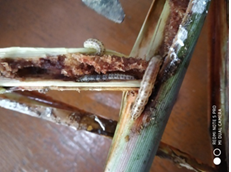Plassey Borer
Plassey Borer
It was referred to as 'Plassey borer’ by Gupta bemuse of its occurrence in an epidemic form at Plassey (West Bengal) during 1956. it is of economic importance only in Assam and Bihar. It also occurs in Nepal, Bangladesh and Burma.
Damage Symptoms
• The incidence of the borer can be easily recognized by the presence of dried crown of infested sugarcane.
• Borer attack occurs in two distinct forms.
• Primary infestation is caused by as many as 156 newly hatched larvae aggregating in the top three to five in internodes.
• Due to such gregarious feeding, fresh red colored frass is seen projecting out of the bore holes and the top leaves of the canes ultimately dry up.
• Affected internodes break off easily and nodes adjacent to the infested internode develop sett roots which completely envelop the stalk; sprouting of nodal buds also occurs.
• In the case of secondary infestation, the grownup larvae disperse to either the lower healthy portion of the canes showing primary attack or the neighboring canes. Larvae feed by tunneling the internodes. One larva may bore into one to five internodes in a cane but cane tops do not dry up in this form of damage.
Management
• Collection of moths in light traps to minimize pest proliferation.
• Collection and destruction of egg masses and cane tops showing primary infestation.
• Conserves the parasitoid Cotesia flavipes and released inoculatively or augmentatively for the control of the borer.
• Release of Trichogramma chilonis egg parasitoids@50000/ha at 10 days interval from July is useful in reducing the infestation level.
• Avoiding indiscriminate use of insecticides and allows them to bring about natural control.
• Detrashing followed by application of systemic insecticides, Diamethoate 30EC @ 2lit. /ha or Chlorpyrifos 20 % EC@ 2.5lit. /ha twice during August and September with one month interval would be useful.



